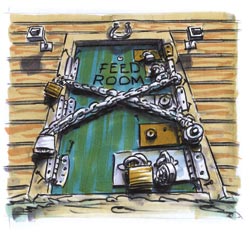|
ideally should be a wide, shallow tub, or by mixing some chopped
forage in with the feed.
 Limit grain to no more than one-half percent of their body weight during each
feeding because of the horses small stomach which means a maximum of five pounds
for a horse that is a thousand pounds. Divide the ration into three equal
feedings if you must give your horse more than one percent of their body weight
in grain each day which is more than ten pounds per day for a horse that is a
thousand pounds. Limit grain to no more than one-half percent of their body weight during each
feeding because of the horses small stomach which means a maximum of five pounds
for a horse that is a thousand pounds. Divide the ration into three equal
feedings if you must give your horse more than one percent of their body weight
in grain each day which is more than ten pounds per day for a horse that is a
thousand pounds.
You should either know the weight of your feed or at least the weight
of the feed in the container you are using. Depending on the bulk
density a two-quart feed scoop can typically hold under two pounds or
almost four pounds of a grain or concentrate feed. A major cause of
colic is the overfeeding of grain so knowing the exact amount you are
giving helps feed the product at a proper rate.
Adequate hay or pasture should be provided. Daily you should feed a
minimum of one percent of the horse’s current body weight which means
about ten pounds for a thousand pound horse. To provide sufficient
forage you will need at least two acres per horse based on seasonal
availability.
Horses should never be allowed to eat moldy feed or hay. Horses are
especially susceptible to a condition known as equine
leukoencephalomalacia or ELEM which is also known as moldy corn disease.
High levels of aflatoxins are found in moldy hay. Symptoms ranging from
digestive upset to severe liver and brain damage which are fatal can be
caused by these fungal toxins.
Feeds should always be kept in areas inaccessible to horses. You should
also take extra caution to prevent horses from consuming feeds labeled
for ruminants only if you have cattle on the same property. Additive
such as monensin, lasolocid or urea are found in these feeds and are
poisonous to horses.
To allow the horses’ large intestine to adapt you to the microbial
population you should change rations slowly. The feeding rate should
never be increased by over a pound each day. Gradually replace the old
feed with the new feed when changing over a seven to ten day period such
as twenty-five percent, then fifty percent and then seventy-five
percent.
When you have a different cutting or a new type of hay you should use
similar methods especially if you are changing between legume hay such
as alfalfa, clover, and grass hay such as timothy, orchard grass,
Bermuda grass, etc. Allow horses to graze only for a few hours when you
first start them on pasture and give them some hay before turning them
out to the pasture.
More energy than good-quality forage is required for growing, breeding
and performance horses. Consider adding a supplement fat to the horse’s
diet or using a fat-added feed with a greater than three percent fat if
you have a horse that requires a larger amount of calories and has to be
given ten pounds of more of grain each day. Adding fat or using a
fat-added feed allows you to feed less grain and more forage since fat
is a more concentrated source of calories. One and a half to two pounds
of grain in a daily ration can be replaced by one pound of stabilized
rice bran.
Both the major and trace minerals should be provided in adequate
amounts. The regulation of body water balance and thirst response to
dehydration depends on adequate mineral consumption and this will help
lessen the risk of impaction colic.
A certified equine dentist should check your horse’s teeth at least one
a year and the teeth should be floated if necessary. You horse can be
prevented from adequate chewing if they have dental problems. By
properly maintain your horses teeth you will decrease their chance of
impaction colic.
Use the guidelines provided by the National Research Council, a
scientific group that is sponsored by the U.S. government to provide
proper feeding guidelines for horses and other animals, to find a
balanced ration for your horses. Check with an equine specialist or
nutritionist if you are in doubt or don’t know what or how to feed your
horse.
The Importance of Exercise and Nutrition
Horses need an environment that is as close to natural as possible with
either daily turnout or grazing. Horses that have regular exercise or
activity have a lower chance of colic than horses that are continuously
stalled according to research studies.

|